The IRS Form 1120 is the U.S. Corporation Income Tax Return. Corporations use this form to report their income, gains, losses, deductions, and credits, as well as to calculate their tax liability. It is essential for corporations to file this form annually to comply with federal tax regulations.
Any corporation that is recognized as a separate legal entity for tax purposes must file Form 1120. This includes:
-
C corporations
-
Foreign corporations engaged in a trade or business in the U.S.
However, S corporations, partnerships, and sole proprietorships do not file this form.
Form 1120 is typically due on the 15th day of the fourth month following the end of the corporation's tax year. For corporations that operate on a calendar year, this means the form is due by April 15. If the due date falls on a weekend or holiday, the deadline is extended to the next business day.
To complete Form 1120, corporations need to provide various pieces of information, including:
-
The corporation's name, address, and Employer Identification Number (EIN)
-
Income details, including gross receipts and other income sources
-
Deductions, such as salaries, rent, and other business expenses
-
Tax credits and any other relevant financial information
Accurate record-keeping throughout the year will make this process smoother.
Yes, corporations can file Form 1120 electronically using the IRS e-file system. E-filing is often faster and more efficient, and it can reduce the likelihood of errors. It also allows for quicker processing of any refunds that may be due.
Failing to file Form 1120 can result in significant penalties. The IRS may impose a failure-to-file penalty, which is typically based on the amount of unpaid tax and the length of time the return is late. Additionally, interest may accrue on any unpaid tax. It's crucial for corporations to file on time to avoid these consequences.
Yes, there is a penalty for late filing. The penalty can be substantial, generally calculated as a percentage of the unpaid tax for each month the return is late, up to a maximum amount. If a corporation owes taxes and fails to file on time, the penalties can add up quickly.
Yes, a corporation can request an extension by filing Form 7004. This form allows for an automatic six-month extension to file the return. However, it is important to note that this extension does not extend the time to pay any taxes owed. Corporations should estimate their tax liability and pay any amount due by the original due date to avoid penalties.
The IRS provides detailed instructions for Form 1120 on its official website. These instructions include information on how to fill out the form, what documentation is needed, and tips for ensuring accuracy. It is advisable to review these instructions thoroughly before starting the filing process.
Corporations can seek assistance from various resources, including:
-
Tax professionals or accountants who specialize in corporate tax filings
-
The IRS website, which offers guidance and FAQs
-
Local IRS offices that may provide in-person assistance
Utilizing these resources can help ensure compliance and accuracy when filing Form 1120.
